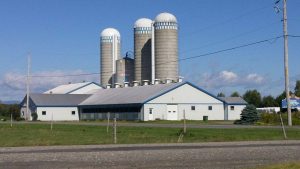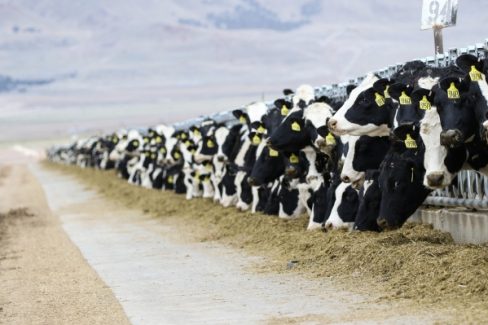Farmers Assuring Responsible Management, dairy’s comprehensive quality assurance program, now covers over 98 percent of America’s milk supply, Emily Yeiser Stepp, FARM animal care director, said during the February Hoard’s Dairyman webinar.
The National Milk Producers Federation presentation was co-hosted by Dr. Mike Hutjens, University of Illinois, and Steve Larson, Hoard’s Dairyman, also included Ryan Bennett, FARM industry & environmental affairs; and Dr. Jamie Jonker, FARM vice president of sustainability & scientific affairs.
The National Dairy FARM program began in 2009 when NMPF, with support from Dairy Management Inc., Initiated a voluntary program for animal care. The goal is to insure consumers and customers that dairy farmers raise and care for their animals and land in a humane and ethical manner.
FARM has since expanded to cover antibiotic stewardship and environmental stewardship.
“This program matters because it helps provide the data and proof points to back up the positive stories on America’s dairies,” Yeiser Stepp said. “It helps provide one consistent, unified program for the entire industry to follow.”
Animal care component
Currently, there are 105 participating co-ops and propriety dairy processors in 49 states. FARM has more than 370 trained evaluators who have, to date, performed 45,00 second-party evaluations.
The animal care component of FARM encourages dairy farmers to follow industry best management practices (BMPs) and FARM’s animal care reference manual, which is updated every three years.
The second tier of the dairy program is implemented through second party evaluations, which include interview questions, animal and facilities observations, a closing interview and follow-up action plans.
“There is also a third-party verification process to make sure we’re hitting our marks and to maintain the integrity of the program,” Yeiser Stepp said.
2017 program
For 2017, a #1 priority in FARM’s animal care “silo” is a valid Veterinarian Client Patient Relationship (VCRP), verified in writing by the farm’s vet of record.
Another key component is having standard operating procedures and making sure employees understand those procedures. Each employee with animal care responsibilities is to sign a dairy cow care ethics and training form. “This form is signed annually and indicates that the employee has received training in stockmanship and his area of responsibility,” Yeiser Stepp explained.
It states the employee will not abuse animals and will report any mistreatment that occurs.
As of Jan.1, 2017, the FARM program includes a ban on tail docking. This is not a change in policy, Yeiser Stepp noted, but rather an accelerated timeline encouraged by veterinarians and the National Mastitis Council.
Research on tail docking shows the practice does not improve milk quality, cow cleanliness or worker safety, she explained.
FARM’s second priority area emphasizes a herd health plan with protocols for newborn and milk-fed calves and pain management, as well as training for non-ambulatory animals and protocols for euthanasia.
Animal observations of lameness, body condition, hocks and knees are also in this phase.
FARM evolves
The first two versions of FARM were survey-based, but there were questions of whether FARM was actually helping with the welfare of the animals if there was no follow-up, Yeiser Stepp said.
That lead to the current FARM version 3.0, which includes accountability measures. For example, dairies that do not meet the hock and the lesion score under priority #2 should, by their next evaluation, show improvement. Dairies that do not meet a #1 priority item must resolve that issue within a year, per their processor or co-op follow-up evaluation.
Failure triggers a 60 day probation. If the issue is not resolved, that dairy is suspended from the FARM program. If the co-op/processor continues to pick up milk from the dairy, it will be suspended from the FARM program and no longer considered in good standing.
Evaluation prep
Preparation for a FARM evaluation includes gathering SOPs information and records, figures on newborn and milk fed calves, and annual nutrition and health data.
A pre-evaluation checklist is available at nationaldairyfarm.com, as well as resources to help meet the evaluation areas, an annual care reference manual, a FARM self-assessment tool, and training logs.
There are also FARM training opportunities for stockmanship, calf care, stewardship and crisis preparedness. Producers should feel free to make use of any or all of them. “We don’t like to ask things that we can’t help you with,” Yeiser Stepp said.
FARM helps farmers
The FARM concept of one widely accepted set of standards is good for food companies and good for dairy farmers.
Rather than trying to develop their own guidelines, companies like Kraft, Chobani, Starbucks, McDonalds, Walmart and many others have chosen FARM as an endorsement of proper animal care practices, Yeiser Stepp said.
For dairy farmers, FARM provides one accepted set of standards to follow and gives the industry a unified voice.
Second silo
The second “silo” in the FARM program is antibiotic stewardship. As outlined by Dr. Jamie Jonker, program participants commit to using BMPs for antibiotic use, having a VCPS, administering all drugs properly and properly identifying all treated animals.
Dairies agree to maintain proper treatment records, conduct training and systems to avoid marketing adulterated milk or medicated products, and market only healthy cattle.
VCPRs are an integral part of proper drug use on cattle, Jonker emphasized, as is a herd health plan that emphasizes prevention, rapid diagnosis and quick decision-making on treatment of all sick and injured dairy cattle.
Looking ahead, Jonker expects the annual update of the residue manual in a few weeks. A new antibiotics pocket guide is in the works, as well as a mobile app expected later in 2017.
Third silo
The third pillar of the FARM program, environmental stewardship, was officially launched Feb. 13.
Designed to capture a dairy’s energy footprint, it uses a model to assess inputs that include milk production, cattle numbers, energy logs and fuel bills to determine the farm’s carbon footprint per pound of fat- and protein-corrected milk.
That final figure can then be compared to regional averages and the national average. “Farms will be able to lower their footprint, saving money and even, may be, making money,” Bennett said.
The environmental stewardship silo is different than the animal care silo, which evaluates dairies every three years. “We don’t see that need, but since farms are being evaluated through Animal Care, we will randomly select 10 percent of the farms, if they want to participate,” he explained.
The new environmental stewardship program, in response to producers’ requests, is in the process of creating a project guide that will be presented in an webinar planned for later in the spring.
Connect with FARM
The FARM program can be found on the web at nationaldairyfarm.com, as well as on Facebook, Twitter and Instagram, #FARMPROUD.
Source:Wisconsin State Farmer




